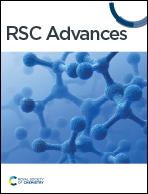Preparation of cyclodextrin polymer-functionalized polyaniline/MXene composites for high-performance supercapacitor†
Abstract
Controlled aggregation is of great significance in designing nanodevices with high electrochemical performance. In this study, an in situ aggregation strategy with cyclodextrin polymer (CDP) was employed to prepare polyaniline (PANI)/MXene (MX) composites. MXene served as a two-dimensional structure template. Due to supramolecular interactions, CDP could be controllably modified with PANI layers, effectively preventing the self-polymerization of PANI. As a result, this integration facilitated a more uniform growth of PANI on MXene and further improved the capacitance performance of CDP-MX/PA. In a three-electrode system, the specific capacitance of MX/PA at 1 A g−1 was 460.8 F g−1, which increased to 523.8 F g−1 after CDP-induced growth. CDP-MX/PA exhibited a high energy density of 27.7 W h kg−1 at a power density of 700 W kg−1. This suggests that the synthetic strategy employed in this study holds promise in providing robust support for the preparation of high-performance energy-storage device.



 Please wait while we load your content...
Please wait while we load your content...